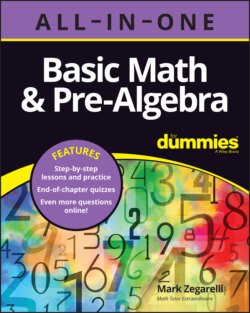Читать книгу Basic Math & Pre-Algebra All-in-One For Dummies (+ Chapter Quizzes Online) - Mark Zegarelli - Страница 29
Take it away: Subtraction
ОглавлениеSubtraction is usually the second operation you discover, and it’s not much harder than addition. Still, there’s something negative about subtraction — it’s all about who has more and who has less. Suppose you and I have been running on treadmills at the gym. I’m happy because I ran 3 miles, but then you start bragging that you ran 10 miles. You subtract and tell me that I should be very impressed that you ran 7 miles farther than I did. (But with an attitude like that, don’t be surprised if you come back from the showers to find your running shoes filled with liquid soap!)
As with addition, subtraction has only one sign: the minus sign (−). You end up with equations such as .
When you subtract one number from another, the result is called the difference. This term makes sense when you think about it: When you subtract, you find the difference between a higher number and a lower one.
One of the first facts you probably heard about subtraction is that you can’t take away more than you start with. In that case, the second number can’t be larger than the first. And if the two numbers are the same, the result is always 0. For example, . Later, someone breaks the news that you can take away more than you have. When you do, though, you need to place a negative sign in front of the difference to show that you have a negative number, a number below 0:
When subtracting a larger number from a smaller number, remember the words switch and negate: You switch the order of the two numbers and do the subtraction as you normally would, but at the end, you negate the result by attaching a negative sign. For example, to find 10 − 13, you switch the order of these two numbers, giving you 13 − 10, which equals 3; then you negate this result to get −3. That’s why 10 − 13 = −3.
The negative sign does double duty, so don’t get confused. When you stick a negative sign between two numbers, it means the first number minus the second number. But when you attach it to the front of a number, it means that this number is a negative number.
